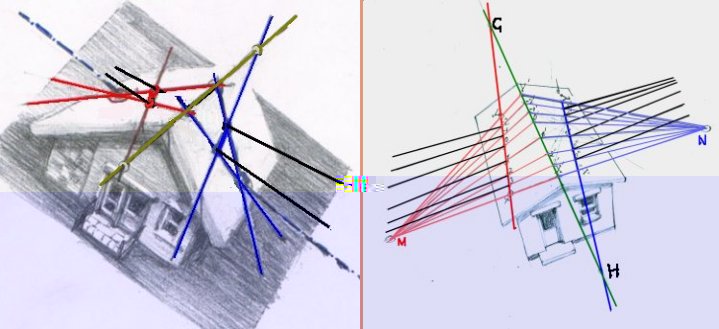Projective Comparison of Skew Rulers
If the lines of the red and blue rulers are skew to each other, there is no way to compare intervals on them by direct elementary incidence, so we must instead compare them by indirect incidence, via an intermediate ruler (here, on the green line). The red ruler and the green are “polyperspectivities” in point M, while the green ruler and the blue are “polyperspectivities” in point N — so that we have a “polyprojectivity”. It works because the green line is the incidence of the two planes, red πM and blue πN, carrying the perspectivities. ↑We may have been here before.↑

So, by conscious construction, we have all three
rulers, red, green and blue,
projectively
identical.
We may care to think - strictly poetically -
of the green ruler as the “central projection” (shadow)
of the red ruler,
by M, into or onto the green line,
and of the blue ruler as the “central projection” (shadow)
of the green ruler,
by N, into or onto the blue line, or vice versa.
of the green ruler as the “central projection” (shadow)
of the red ruler,
by M, into or onto the green line,
and of the blue ruler as the “central projection” (shadow)
of the green ruler,
by N, into or onto the blue line, or vice versa.
We get a set of (here, black) lines
in which each is skew to all the other lines in the set.
This means that
they have no mutual incidence of any kind — so they cannot lie in a surface,
at least not one composed of geometric elements, because none is available.
It is certainly not a developable surface. This fundamental issue is discussed here.
in which each is skew to all the other lines in the set.
This means that
they have no mutual incidence of any kind — so they cannot lie in a surface,
at least not one composed of geometric elements, because none is available.
It is certainly not a developable surface. This fundamental issue is discussed here.
What we seem to see is
the black skew lines forming a line-wise ‘envelope’, perhaps tangent to some sort of curve
the black skew lines forming a line-wise ‘envelope’, perhaps tangent to some sort of curve
(to see this more clearly, drag the yellow dot, K, back and forth: adjust their distribution with U and D).
Now, it should be clear that they cannot actually do this , because, as already noted, they have no mutual incidence, and so have nothing to which to be tangent. What we in fact see are their "shadows" on the plane of the screen, and because these shadows are coplanar , they are not skew, and are incident, and could be tangents to a curve -
which might be one of the conics.
It is instructive to click-and-drag
the green line
anticlockwise around point C.
You should see all the variations of the curve.
the green line
anticlockwise around point C.
You should see all the variations of the curve.
But do please note that this implied curve is a projective shadow, and not an actual profile of a 3D surface.
It is also instructive to move point H to lie exactly on point
G. You can do this by rotating the blue line. You should see all
the black skews become a pencil in a single point, and the curve collapse
into that point.
This is in fact a Desargues configuration.
and there can be no extended curve with such a configuration.
and there can be no extended curve with such a configuration.
Issues of continuity remain,
but this (uncollapsed) curve is the first to arise exclusively
from Elementary Incidence.
And if it is in fact a continuous curve,
we can, using it, tackle
the imaginary, and with that, projective rotation.
![Projective vs Euclidean proof [Click]](images/two_plane_smaller.jpg)